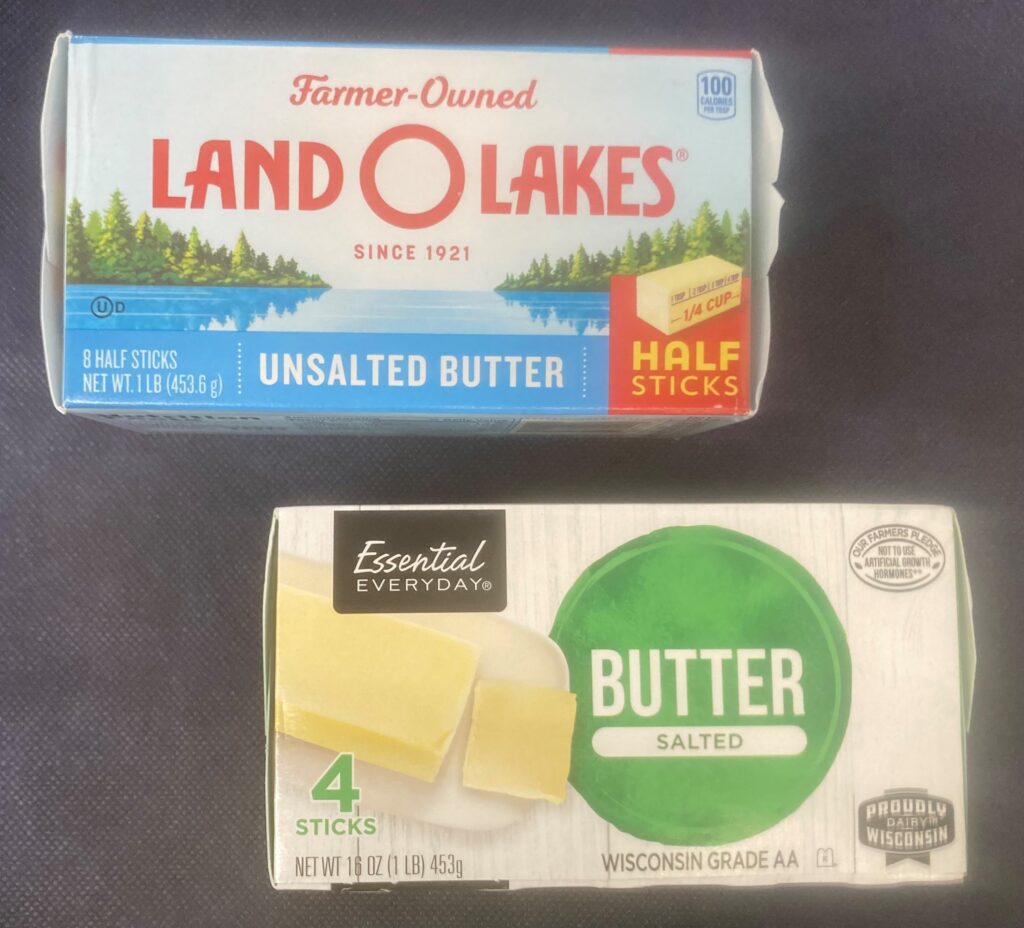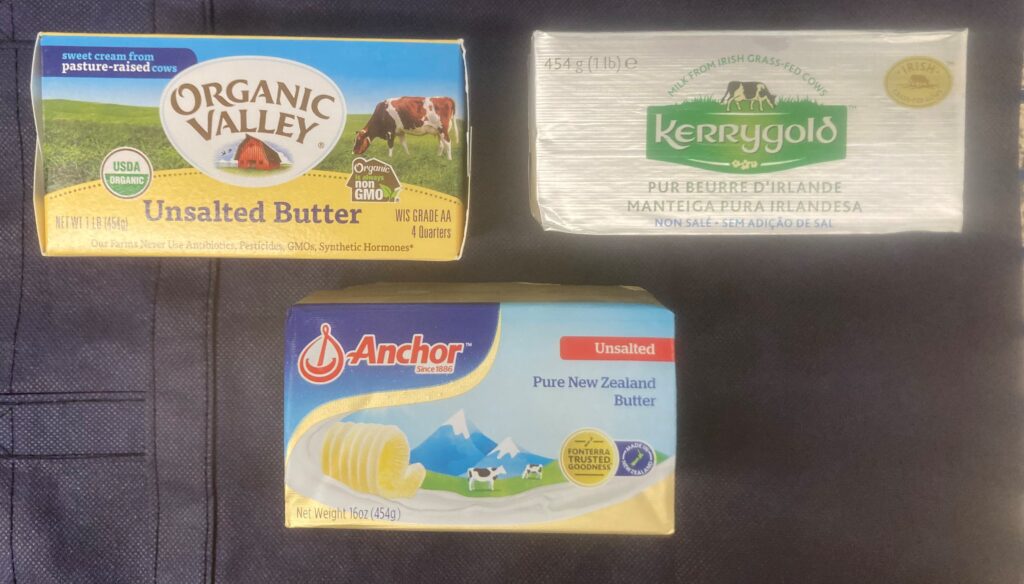by Anne Evans
Butter brands ARE NOT interchangeable.
Some butters are “salted” and some are “unsalted” – and it’s always better to bake (or cook) with unsalted butter so that you can control the salt content of the recipe.
In my opinion, the only use of salted butter is for use when dining (e.g., as a spread on bread). However, personally I don’t care to use salted butter ever – far preferring the taste of unsalted butter – aka sweet butter. Ever since my mother took me on my first trip to Europe in 1966 and I tasted sweet cream butter spread on a freshly baked croissant, I was hooked.
There are also significant differences in the butterfat and water content of different brands of butter, particularly when comparing American-style versus European-style brands. Those variations can have a significant impact on the outcome of the creation you’re baking.
American-style butter, both salted and unsalted, is generally sold as four 4oz sticks in 1 lb. packages. American-style butter (made in the U.S.) is required by the USDA to have at minimum 80% butterfat and no more than 16% water. The remaining percentage is a combination of milk solids +/- salt. Before I became an expatriate, I relied on American-style, unsalted organic butters – all of which I assumed were interchangeable.

BTW, never try to substitute whipped butter volume-for-volume for block butter when baking. According to United States legal requirements, whipped butter has to contain only a minimum of 25% butterfat – due to the uniform incorporation of air or inert gas into butter.
European-style butters have a higher butterfat content and less water. European-style butters average around 82 percent butterfat, but some have as much as 84 percent. That extra butterfat means less water – which can be a good thing or not. It depends on what you are baking. AND these butters are frequently packaged differently than American Style Butters, so let the buyer be aware!

European-style butters in general:
- Have more flavor – so they are best suited for recipes where butter is the predominant flavor (think butter cookies and laminated doughs such as croissants, puff pastry, and buttercream frostings)
- In products such as cookies, they will tend to make the cookies spread more, brown more, and become crispier
- Are more expensive because cows’ milk is more expensive than water
American-style butters in general:
- Have less flavor – so they are best suited for recipes where butter is NOT the predominant flavor (think, chocolate chip cookies where it is all about the chocolate)
- Offer benefits (due to their increased water content) to pastries that rely on the steam released from the water in the butter for lightness (think, Pâte à choux, and gougères)
- Are the best choice for your inherited handwritten recipe for my (or your) American Great Aunt’s Sugar Cookies which probably relied on American-style butter – so if you substitute European-style butter, anticipate a different end product
- Are less expensive because water is less expensive than cows’ milk
I’m unaware of any American-style butters made outside of the US, due to the higher quality/butterfat standards of non-US countries.
Here in The Cayman Islands, grocery stores offer a variety of brands of butter. Some I am familiar with; some I am not. Some are American-style; some are European-style. Some are imported from the US; some are not. And then there is also the nebulous generic store brand (in this case, “Essentials Everyday”). There are extreme ranges in price. Also, there are variations in the packaging that a baker will need to pay attention to.
Generally, I am a believer in the “you get what you pay for” – however, not sure that holds true on the Cayman Islands, in part due to import tariffs. Interestingly, there is no tariff levied on the import of butter – unlike most products where there is generally a 17-22% tariff. Perhaps this is because all butter is imported and there appear to be no options to purchase locally made butter – or at least nonsufficient to meet the need?
So why the large variation in butter costs on these Islands? The Cayman Islands (TCI) are a British Overseas Territory. The United Kingdom includes Northern Ireland, and New Zealand is part of the British Commonwealth. Obviously, the US is none of the above. In general, when shopping on TCI, I have learned that I will pay a premium for US products, while products obtained from regions that have a governmental relationship with the UK will be considerably less. I cannot tell you if this is the result of target pricing for American Tourists willing to pay a premium for familiar brands – or instead due to contracts with UK affiliated product providers that allow for more favorable pricing.
So, my choice for butter here is Anchor Unsalted Butter from New Zealand. In my baking, it has offered the correct balance between percent butterfat, flavor, and price point and provides consistent results in all my recipes.
In the table below, I compare some of the American-style butters that are available in the Cayman Islands to those that are European-Style butters and available on Grand Cayman.



One comment